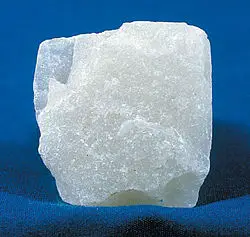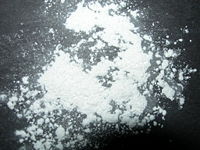Talc
| Talc | |
|---|---|
 A block of talc |
|
| General | |
| Category | Mineral |
| Chemical formula | Mg3Si4O10(OH)2 |
| Identification | |
| Color | white to gray or green |
| Crystal habit | foliated to fibrous masses |
| Crystal system | Monoclinic |
| Cleavage | perfect basal cleavage |
| Mohs Scale hardness | 1 |
| Luster | waxlike or pearly |
| Streak | White |
| Specific gravity | 2.5-2.8 |
Talc (derived from the Persian via Arabic talq) is a mineral composed of magnesium silicate hydroxide. It is extremely soft, with a greasy feel. It is translucent to opaque and has a pearly luster. Its color ranges from white to gray or green, and its streak (color of the fine powder) is white.
This mineral serves a number of useful roles. It is widely known for its use in baby powder and cosmetics. It is also a lubricant, a filler in paper manufacture, and a component in paints, ceramics, and roofing materials. Tailor's chalk and the chalk used for welding and metalworking often consist of talc. It is also an additive in some foods and pharmaceutical products. Soapstone, a high-talc rock, is an ornamental stone and is also used for countertops, stoves, sinks, and electrical switchboards.
Formation
Talc is a metamorphic mineral. It is produced by the metamorphism of magnesian minerals—such as pyroxene, amphibole, or olivine—in the presence of carbon dioxide and water. This process, called talc carbonation or steatization, produces a suite of rocks known as talc carbonates.
Talc is formed primarily via hydration and carbonation of serpentine, via the following reaction:
- Serpentine + Carbon Dioxide → Talc + Magnesite + Water
Talc can also be formed by a reaction between dolomite and silica:
Another reaction that produces talc involves magnesian chlorite and quartz in blueschist and eclogite metamorphism:
In the last of these reaction, the proportions of talc and kyanite depend on aluminum content, with the production of kyanite being favored when the rock is more aluminous.
Occurrence
Talc is a common mineral in metamorphic belts that contain ultramafic rocks, such as soapstone (a high-talc rock), and within whiteschist and blueschist metamorphic terranes. Prime examples of whiteschists include the Franciscan Metamorphic Belt of the western United States, the western European Alps (especially in Italy), certain areas of the Musgrave Block, and some collisional orogens such as the Himalayas.
Talc carbonated ultramafics are typical of many areas of the Archaean cratons, notably the komatiite belts of the Yilgarn Craton in Western Australia. Talc-carbonate ultramafics are also known from the Lachlan Fold Belt, eastern Australia, from Brazil, the Guyana Shield, and from the ophiolite belts of Turkey, Oman, and the Middle East.
A notable talc mine of economic importance is at Mount Seabrook in Western Australia. It is formed on a polydeformed, layered, ultramafic intrusion.
Characteristics
The chemical formula of talc may be written as Mg3Si4O10(OH)2 or H2Mg3(SiO3)4. The mineral occurs as foliated to fibrous masses. Its monoclinic crystals are so rare as to be almost unknown. It has a perfect basal cleavage, and the folia are non-elastic, although slightly flexible. It is the softest material on the Mohs scale of mineral hardness—its hardness rating is 1. Its specific gravity is in the range of 2.5–2.8. Soapstone or steatite—a coarse, grayish-green, high-talc rock—is heat-resistant and acid-resistant, and is an electrical insulator.
Uses
Talc finds use as a cosmetic (talcum powder), a lubricant, and a filler in paper manufacture. As a baby powder, it is an astringent that helps prevent rashes in the area covered by a diaper. It is also a component in paints, ceramics, and roofing materials. Most tailor's chalk is talc, as is the chalk often used for welding or metalworking. It is also an additive in some foods and pharmaceutical products.[1] Moreover, soapstone is used as an ornamental stone and for several practical purposes, such as for stoves, sinks, countertops, and electrical switchboards.
Safety
Several studies have established preliminary links between talc and pulmonary problems,[2] lung cancer,[3][4] skin cancer, and ovarian cancer.[5] These studies have raised public concern, considering talc's widespread commercial and household use. However, no conclusive study has yet been made to determine the toxicity or carcinogenic nature of talc under normal conditions of human exposure. The long history of safe use suggests that these concerns are unfounded. The U.S. Food and Drug Administration (FDA) considers non-asbestiform talc—that is, talc that does not contain potentially carcinogenic asbestiform amphibole fibers—to be in the group of "Generally recognized as safe" (GRAS) materials that can be used in cosmetics.
See also
Notes
- ↑ In the European Community, the additive number is E553b.
- ↑ M. A. Hollinger, "Pulmonary toxicity of inhaled and intravenous talc," Toxicol. Lett. 52(2) (1990): 121-127. Retrieved April 14, 2007.
- ↑ National Toxicology Program, "NTP Toxicology and Carcinogenesis Studies of Talc (CAS No. 14807-96-6) (Non-Asbestiform) in F344/N Rats and B6C3F1 Mice (Inhalation Studies)," Natl. Toxicol. Program Tech. Rep. Ser. 421 (1993): 1-287. Retrieved April 14, 2007.
- ↑ "Health effects of mining and milling talc," NIOSH Worker Notification Program. Retrieved April 14, 2007.
- ↑ B. L. Harlow et al., "Perineal exposure to talc and ovarian cancer risk," Obstetrics and Gynecology 80(1) (1992): 19-26. Retrieved April 14, 2007.
ReferencesISBN links support NWE through referral fees
- Farndon, John. 2006. The Practical Encyclopedia of Rocks & Minerals: How to Find, Identify, Collect and Maintain the World's best Specimens, with over 1000 Photographs and Artworks. London: Lorenz Books. ISBN 0754815412
- Klein, Cornelis, and Barbara Dutrow. 2007. Manual of Mineral Science, 23rd ed. New York: John Wiley. ISBN 978-0471721574
- Pellant, Chris. 2002. Rocks and Minerals. Smithsonian Handbooks. New York: Dorling Kindersley. ISBN 0789491060
- Shaffer, Paul R., Herbert S. Zim, and Raymond Perlman. 2001. Rocks, Gems and Minerals, Rev. ed. New York: St. Martin's Press. ISBN 1582381321
External links
All links retrieved February 26, 2023.
- Talc Mineral Data – Webmineral.com
- Talc – Mindat.org
Credits
New World Encyclopedia writers and editors rewrote and completed the Wikipedia article in accordance with New World Encyclopedia standards. This article abides by terms of the Creative Commons CC-by-sa 3.0 License (CC-by-sa), which may be used and disseminated with proper attribution. Credit is due under the terms of this license that can reference both the New World Encyclopedia contributors and the selfless volunteer contributors of the Wikimedia Foundation. To cite this article click here for a list of acceptable citing formats.The history of earlier contributions by wikipedians is accessible to researchers here:
The history of this article since it was imported to New World Encyclopedia:
Note: Some restrictions may apply to use of individual images which are separately licensed.


